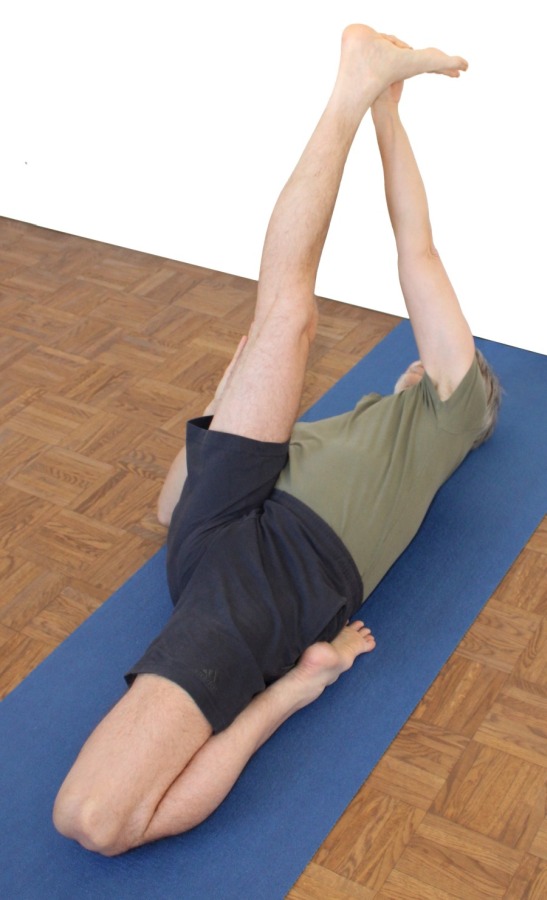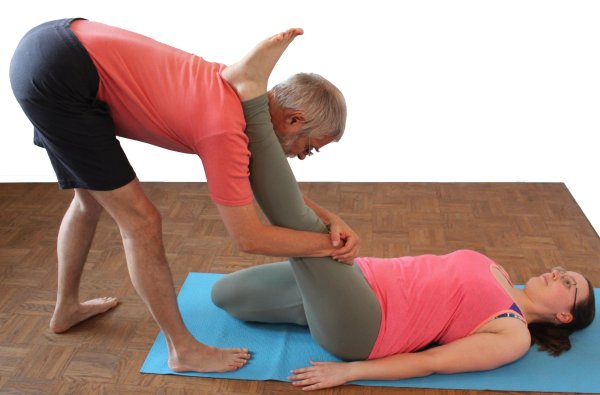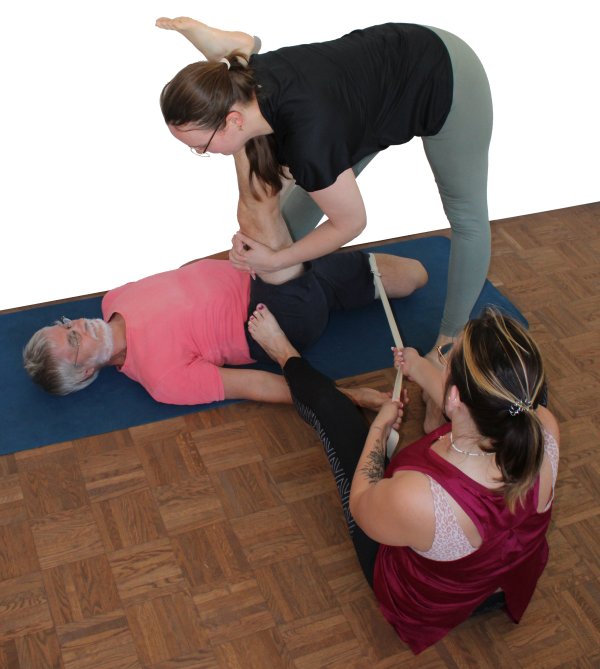yogabuch / asanas / supta krouncasana
supta krouncasana
„lying heron“

 instructions and details with working links as PDF for download/print
instructions and details with working links as PDF for download/print
Feedback: We’d love to hear what you think about this description, give us feedback at:
postmeister@yogabook.org
last update: 12/30/2018
Name: supta krouncasana
Trivial name: lying heron
Level: A
- Classification: A
- Contraindication
- effects
- Preparation
- follow-up
- derived asanas
- similar asanas
- diagnostics
- Instruction
- details
- Variants
Classification
classic: posture
Contraindication
Effects
- (721) Stretching of the hamstrings
- (811) Stretching of the quadriceps
- (816) Stretching of the rectus femoris
- (841) Stretching of the foot lifts
- (851) Stretching the biarticular calf muscles (gastrocnemius)
Preparation
The posture creates a very large stretch in the hamstrings, so prepare it with:
- uttanasana as a generally effective and efficient stretch of the hamstrings to prepare for flexion in the hip joints in this pose
- prasarita padottanasana
- parsvottanasana
- downface dog as another good preparation for the ischiocrural group when the pelvis is tilted powerfully
- hip opener 5 as a very effective stretch of the hamstrings that goes beyond uttanasana
- krouncasana
The flexibility of the lumbar hip extensors (especially the gluteus maximus) may also be a limitation, which is helpful:
Another major requirement is the flexibility of the quadriceps, especially the rectus femoris, so prepare with:
and various effective backbends.
Follow-up
derived asanas:
similar asanas:
Diagnostics (No.)
A pronounced thoracic spine kyphosis would mean that the back cannot lie flat on the floor but remains kyphotic and feels pressure at the point of contact. See also the FAQ.
(811)(711) Quadriceps and hip flexors
The main reason for the inability to keep the knee joint of the folded leg on the ground under the pull on the extended leg is the restriction of flexibility of the rectus femoris and iliopsoas. By pulling the knee on a very long lever, the extended leg tilts the pelvis out of the hyperlordosis and pulls up the thigh of the flexed leg via the rectus femoris and the hip flexors. If the pelvis is significantly higher on the side of the bent leg than on the other side, the monoarticular quadriceps partsare under such high tension that the resulting extension moment in the knee joint is not balanced out by the flexion moment resulting from the partial body weight. We can also recognize the pull of the rectus femoris arising laterally from the acetabulum (spina iliaca anterior inferior) by the inclination of the pelvis to turn away from the leg remaining on the ground in the plane and by the outward inclination of the leg.
In this intensive one-sided forward bend(flexion in one hip joint), various disorders can be found:
- Shortening of the hamstrings, see FAQ.
- Damage to the hamstrings, which causes pain or functional limitations, can also be easily recognized here, from simple shortening with a very intense stretching sensation to tension with an agonizing note to strains and muscle (attachment/detachment/tear).
- Irritation of the sciatic nerve: irritation of the sciatic nerve, which innervates the leg and foot, can become symptomatic during forward bends in particular, even if they are otherwise rather calm. See the FAQ.
- Irritation of the origin of the hamstrings at the ischial tuberosity (at the ischial tuberosities, also known as PHT: proximal hamstring tendinopathy) will be clearly evident in this posture and require protection from intensive stretching, as this posture demands; see the FAQ.
- Baker’s cysts create a feeling of tension or foreign body in the back of the knee, see FAQ.
(884) Knee
In this pose, knee problems associated with wide bending, such as here in the folded leg, are revealed very well. These can be, for example: traumatic or degenerative meniscus damage, arthrosis, arthritis, subluxations, ligament damage, plica syndrome (of the extended leg) and others, see FAQ.
(880) Hyperextension of the knee joint in the stance leg:
Overextension of the knee joint refers to the ability to or even the current state of an angle greater than 180° in the knee joint. To a certain extent, this is considered normal by anatomists and is on average more common and more pronounced in women. However, it can also indicate a weakness of the quadriceps. Furthermore, hyperextension often causes unphysiological sensations that are not caused by stretching or exertion of the muscles and should be avoided, see also the FAQ.
Variants:
Instructions
- Lie in supta virasana.
- Turn slightly to the left side and pull the right leg out of the folded position.
- Bend at the right hip joint to move the leg towards the chest and straighten the right leg.
- If you have good flexibility, grasp the right outer foot with the left hand or, alternatively, the right big toe with the left index and middle fingers and pull the right leg stretched as close as possible to the chest.
Details
- As in the related but much simpler ardha supta krouncasana, the pelvis tends to move away from the left foot which remains on the floor. Correct by lifting the pelvis and pushing it towards the left foot. As in supta virasana, there should be no distance between the foot and the pelvis.
- The left leg that remains on the floor wants to move out to the left and upwards. Use the strength of the adductors to keep it parallel to the spine and the strength of the pomus muscles and the hamstrings to keep it on the floor. The leg also tends to turn inwards.
- The lifted leg has a great tendency to bend at the knee joint. Extend it with quadriceps strength. This also uses the rectus femoris, which has a clear tendency to spasm due to its function as a hip flexor and the fact that it is in very short sarcomere length and therefore close to active insufficiency. The leg should be brought up more using the strength of the left arm, which can and must of course also bend if it is mobile. The left elbow moves outwards.
- Not only does the left leg move outwards, the pelvis also rotates a little in the plane so that the lumbar spine bends slightly sideways and the sacrum is no longer in the axis of the thoracic spine. This can be remedied a little by pushing the buttock of the right leg away from the back.
- The right leg moves less towards the right armpit and more towards the center of the lateral nipple. Pull with the contralateral hand so that the other hand remains free to push against the right leg from the outside if the body tends to tilt to the right. It is also much easier to pull the right leg towards the sternum with the left arm instead of the armpit, which would be much more difficult with the right arm.
- The pelvis is higher on the left than on the right. This is caused by the moment with which the left quadriceps in the left knee joint wants to extend or the resulting force that lifts the pelvis on the left. This weakens over time by practicing quadriceps stretch 1 and virasana.
- The effect of the posture is usually very intense, depending on the individual’s different flexibility, more in the left rectus femoris or in the right hamstrings.
- This is not a beginner’s exercise. First of all, supta virasana must be performed without major restrictions and uttanasana and other forward bends should show a flexion of well over 90° in the hip joints. In many cases, a belt will be required with a loop around the right foot to pull the leg towards the chest. What has been said in postures such as hasta padangusthasana about arm and leg length and the exact angle at which both arm and leg can be stretched when reaching for the outer foot or big toe applies analogously here. If you have very good flexibility, bend the left elbow joint to the outside left and pull the leg as far as possible towards the chest.
- Take care not to turn the lifted leg out.
- The shoulder of the left pulling arm should rest on the floor as much as possible, bending the left arm at the elbow joint pulls the leg further towards the upper body at the foot.
- As in supta virasana, turn the left leg out, i.e. the inner knee up and the outer knee down.
- The pull on the right foot exerts a significant tilting moment on the pelvis via the lever arm of the extended right leg, which attempts to tilt the pelvis out of any remaining flexion in the left hip joint and leads to a large stretch in the left rectus femoris, as this covers the hip joint. As a result, there will be much less of a hollow back compared to supta virasana. By design, this is one of the few poses in which the quadriceps and hamstrings (of different legs, of course) are stretched at the same time and one of these poses whose space for further stretching is unlikely to be exhausted so quickly. Which muscle group is stretched more depends on both the preparation and the flexibility of the group itself. Naturally, a stronger pull on the right foot will increase the tendency of the left knee to move upwards and outwards.
- Stretch the heel and inner foot away in the leg pulled towards the chest.
Variations
with counter pressure

Improved extension in the knee joint
Instructions
- Take the pose as described above, but press against the thigh with the forearm on the same side to stretch the knee joint.
Details
- Due to the pull of the hamstrings that bends the knee, the knee joint has a pronounced tendency to bend in this posture. This can be counteracted with the arm.
With belt

Enabling the posture for the very mobile
Instructions
- After pulling the right leg out of supta virasana, place a belt around the right foot to pull the leg towards the chest and stretch it.
Details
- As indicated above, a belt will be required in most cases.
- Place the belt around the foot close to the heel to avoid unintentionally stretching the gastrocnemius intensely, which could restrict the execution of the flexion in the hip joint.
(P)

Instructions
- Take the pose as described above.
- The supporter approaches from the foot side of the body, places the lower leg near the heel of the lifted leg on one shoulder and slowly presses harder and harder to the desired intensity with both forearms against the middle of the thigh to better extend the lifted leg, while carefully leaning further towards the chest of the performer with the extended leg in the position described to further bend the leg at the hip joint.
Details
- The above applies to intensity and location, except that it is reinforced by the use of the supporter
- As the supporter, first extend the knee joint and then move the extended leg further towards the chest. Any hyperextension usually resolves itself when the leg is flexed further in the hip joint: first the discomfort caused by hyperextension disappears and a few additional degrees of hip flexion later the hyperextension itself also disappears.
(P) Correcting the leg
Instructions
- Take the pose as described above.
- The supporter sits straight in front of the lower leg of the performer, pulls it inwards(medially) until it is parallel to the body axis and in doing so limits the resulting (and previously created) evasive movement of the pelvis in relation to the same leg in the form of rotation in the plane, i.e. by pulling on the contralateral outer ridge, cancels the rotation of the pelvis and the resulting lateral flexion of the lumbar spine.
Details
- As the rectus femoris is under high tension due to the traction on the lifted leg, it will cause an evasive movement in the hip joint. Depending on what the punctum fixum and punctum mobile are, the pelvis will deviate in the sense of rotation in the plane, i.e. into increased abduction in the relevant hip joint, as the thigh is corrected and fixed by a supporter. This is due to the course of the rectus femoris laterally past the hip joint. If only the pelvis were fixed, the lower leg would move laterally accordingly. As the knee usually only rests very lightly on the floor anyway (if at all), the second of these options is the most common in practice. However, if the knee is corrected and fixed medially by a supporter, the second evasive movement occurs.
(2P)

Instructions
- Take the pose as described above.
- The first supporter performs the standard support described above. The second supporter sits on the side of the lifted leg and pulls the outwardly bending leg towards him by a belt placed around the thigh of the bent leg until the thigh is parallel to the sagittal plane. The free end of the belt points medially (and therefore towards the second supporter), the buckle lies high up on the thigh. By pulling on the belt, the second supporter builds up counterpressure with the foot against the side of the pelvis facing him.
Details
- The full support also eliminates the evasive movements that result from the use of the first supporter in such a way that the bending leg deviates more to the outside. The result is a very precise and intense posture.
